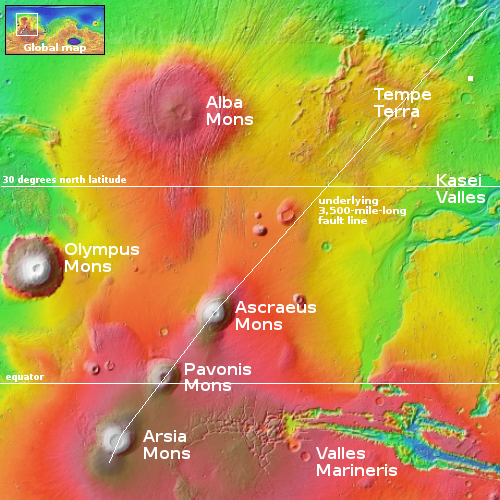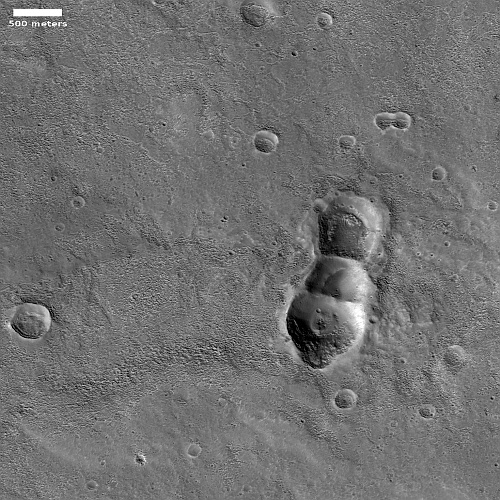Triple crater on Mars
Cool image time! The picture to the right, cropped, reduced, and sharpened to post here, was taken on January 22, 2023 by the high resolution camera on Mars Reconnaissance Orbiter (MRO). It shows what the scientists have labeled simply as a “triple crater,” a very apt description.
What caused this? The most obvious explanation is the arrival almost simultaneously of three pieces. As this asteroid or comet entered the thin Martian atmosphere as a single object, that atmosphere was thick enough to break it into three parts but not enough to destroy it entirely. When it hit the ground, the top piece hit first, with the center and bottom pieces following in sequence, thus partly obscuring the previous hits.
The smaller surrounding craters could either be additional pieces from the bolide, or secondary impacts from ejecta thrown out at impact.

The white dot northeast of Tempe Terra on the overview map to the right marks the location of this triple crater, and suggests that both ice and lava were involved in its final formation.
At 44 degrees north latitude, this location likely has a lot of near surface ice, which is also indicated by what look like glacial features inside most of the craters in this picture.
Located northeast of Mars’s volcanic Tharsis Bulge where its biggest volcanoes are located, the surface here could easily be flood lava as well. The white line on the map marks the location of the giant 3,500-long fault that runs through this region of past volcanic activity. Its nearness also suggests the presence of lava.
Hit both with a big enough rock from space, and both will instantly melt and be flung as liquid away from the impact. You can see indications of this mixed flow in the stippled mound descending from the impact in both east and west directions. Note how some of the smaller craters seem partly buried by it. The larger crater on the far left, apparently untouched by the flow, probably occurred much later, after the flow had solidified.
The distorted shapes of the triple craters also suggests water ice was involved in this impact. Melted rock would more likely solidify as a clean circular crater.
On Christmas Eve 1968 three Americans became the first humans to visit another world. What they did to celebrate was unexpected and profound, and will be remembered throughout all human history. Genesis: the Story of Apollo 8, Robert Zimmerman's classic history of humanity's first journey to another world, tells that story, and it is now available as both an ebook and an audiobook, both with a foreword by Valerie Anders and a new introduction by Robert Zimmerman.
The print edition can be purchased at Amazon or from any other book seller. If you want an autographed copy the price is $60 for the hardback and $45 for the paperback, plus $8 shipping for each. Go here for purchasing details. The ebook is available everywhere for $5.99 (before discount) at amazon, or direct from my ebook publisher, ebookit. If you buy it from ebookit you don't support the big tech companies and the author gets a bigger cut much sooner.
The audiobook is also available at all these vendors, and is also free with a 30-day trial membership to Audible.
"Not simply about one mission, [Genesis] is also the history of America's quest for the moon... Zimmerman has done a masterful job of tying disparate events together into a solid account of one of America's greatest human triumphs."--San Antonio Express-News
Cool image time! The picture to the right, cropped, reduced, and sharpened to post here, was taken on January 22, 2023 by the high resolution camera on Mars Reconnaissance Orbiter (MRO). It shows what the scientists have labeled simply as a “triple crater,” a very apt description.
What caused this? The most obvious explanation is the arrival almost simultaneously of three pieces. As this asteroid or comet entered the thin Martian atmosphere as a single object, that atmosphere was thick enough to break it into three parts but not enough to destroy it entirely. When it hit the ground, the top piece hit first, with the center and bottom pieces following in sequence, thus partly obscuring the previous hits.
The smaller surrounding craters could either be additional pieces from the bolide, or secondary impacts from ejecta thrown out at impact.

The white dot northeast of Tempe Terra on the overview map to the right marks the location of this triple crater, and suggests that both ice and lava were involved in its final formation.
At 44 degrees north latitude, this location likely has a lot of near surface ice, which is also indicated by what look like glacial features inside most of the craters in this picture.
Located northeast of Mars’s volcanic Tharsis Bulge where its biggest volcanoes are located, the surface here could easily be flood lava as well. The white line on the map marks the location of the giant 3,500-long fault that runs through this region of past volcanic activity. Its nearness also suggests the presence of lava.
Hit both with a big enough rock from space, and both will instantly melt and be flung as liquid away from the impact. You can see indications of this mixed flow in the stippled mound descending from the impact in both east and west directions. Note how some of the smaller craters seem partly buried by it. The larger crater on the far left, apparently untouched by the flow, probably occurred much later, after the flow had solidified.
The distorted shapes of the triple craters also suggests water ice was involved in this impact. Melted rock would more likely solidify as a clean circular crater.
On Christmas Eve 1968 three Americans became the first humans to visit another world. What they did to celebrate was unexpected and profound, and will be remembered throughout all human history. Genesis: the Story of Apollo 8, Robert Zimmerman's classic history of humanity's first journey to another world, tells that story, and it is now available as both an ebook and an audiobook, both with a foreword by Valerie Anders and a new introduction by Robert Zimmerman.
The print edition can be purchased at Amazon or from any other book seller. If you want an autographed copy the price is $60 for the hardback and $45 for the paperback, plus $8 shipping for each. Go here for purchasing details. The ebook is available everywhere for $5.99 (before discount) at amazon, or direct from my ebook publisher, ebookit. If you buy it from ebookit you don't support the big tech companies and the author gets a bigger cut much sooner.
The audiobook is also available at all these vendors, and is also free with a 30-day trial membership to Audible.
"Not simply about one mission, [Genesis] is also the history of America's quest for the moon... Zimmerman has done a masterful job of tying disparate events together into a solid account of one of America's greatest human triumphs."--San Antonio Express-News


